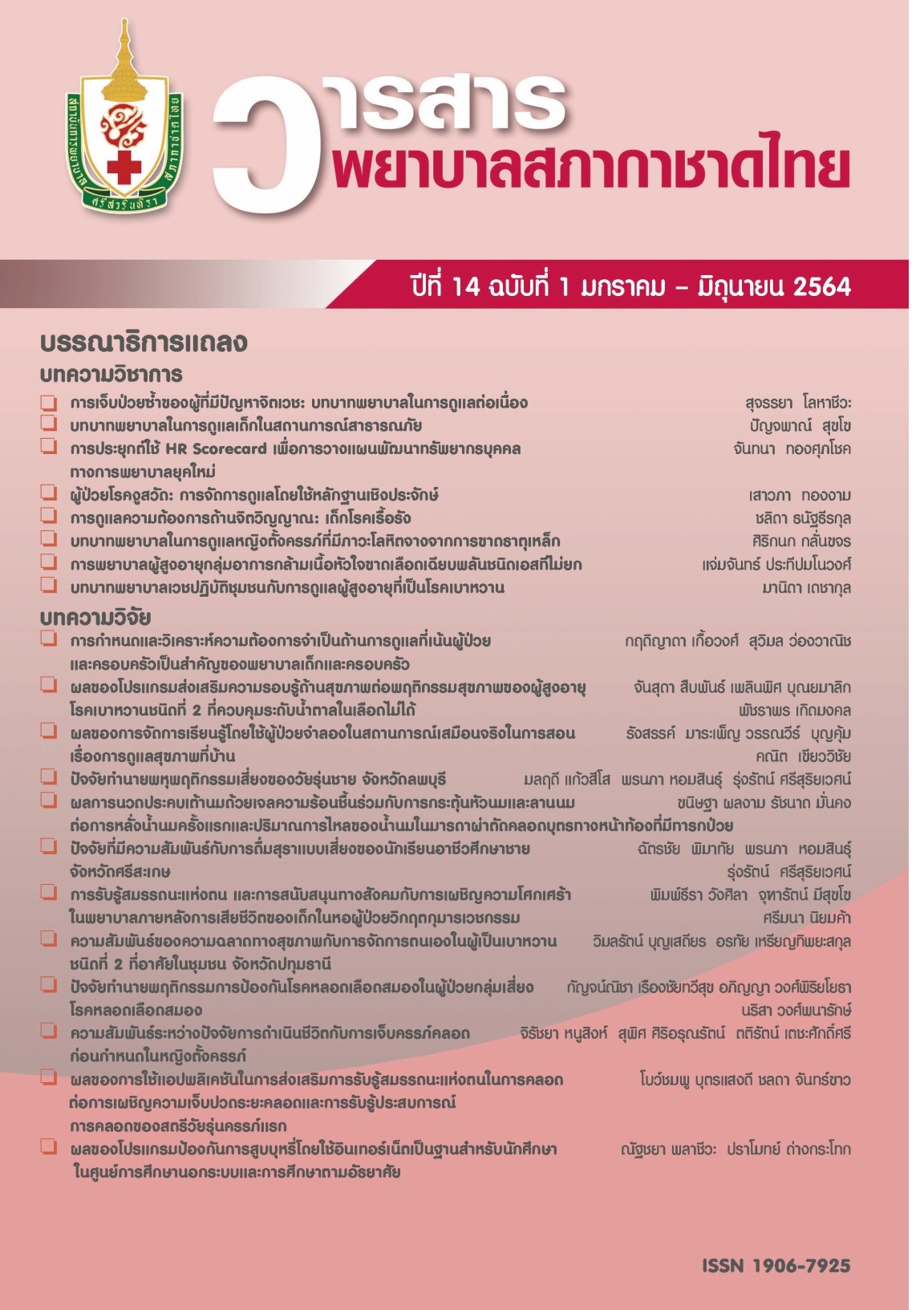Predicting Factors of Multiple Risk Behaviors Among Male Adolescents in Lopburi Province
Keywords:
male adolescents, risk-taking behavior, multiple risk behaviorsAbstract
This predictive correlation design aimed to identify multiple risk behaviors and to examine the factors related to multiple risk behaviors among male adolescents in Lopburi province. The Theory of Triadic Influence (TTI) was used as a conceptual framework. The total sample inlcuded 318 males who were higher secondary school students. The data were collected using self-administered questionnaires including consisting of demographic data, stress, attitude towards risk behaviors, risk behavior, refusal self-efficacy, peer influence, access to media/ stimulus, family risk behaviors and family attachment questionnaires. The reliability ranged between 0.69-0.95. Data were analyzed using descriptive statistics and binary logistic regression.
The results of the study revealed that the prevalence of multiple risk behaviors was 50%. The significant factors influencing multiple risk behaviors among male adolescents were attitude towards risk behaviors (AOR = 12.63, 95% CI = 6.47-24.68), risk behavior refusal low self-efficacy (AOR = 4.10, 95% CI = 2.10-8.00), peer influence (AOR = 3.04, 95% CI = 1.51-6.12), and low academic achievement (AOR = 1.95, 95% CI = 1.00-3.78). For the other variables, stress, family income, father’s education, mother’ s education, parental attachment, family risk behaviors and media access, there were no significant effects on multiple risk behaviors. The study outcome will enable authorities to understand risk behaviors and could be used to develop an efficient program, so as to prevent male adolescents from multiple risk behaviors.
References
2. Center for Disease Control and Prevention [CDC]. Adolescent and school health [Internet]. 2018 [cited 2019 Jan 23]. Available from: https://www.cdc.gov/healthyyouth/data/yrbs /index.htm?s_cid=hy-homepage-002.
3. Orathai P, Nintachan P. Testing psychometric properties of the risk-taking behavior questionnaire for Thai adolescents. Journal of Nursing and Health Sciences 2014;8(3 Suppl.):212-21. (in Thai)
4. Lopburi Social Development and Human Security. Report of social situation among Lopburi province 2015 [Internet]. 2015 [cited 2019 Feb 12]. Available from: www.lopburi.m-society.go.th/?wpfb_dl=51. (in Thai)
5. Kipping RR, Campbell RM, MacArthur GJ, Gunnell DJ, Hickman M. Multiple risk behaviour in adolescence. Journal of Public Health 2012;34(suppl_1):i1-i2.
6. Hale DR, Viner RM. The correlates and course of multiple health risk behaviour in adolescence. BMC Public Health 2016;16(458):1-12.
7. Duangkaew K, Powwattana A, Auemaneekul N. Factors related to multiple risk behaviors among vocational students in Bangkok. Journal of Public Health Nursing 2017;31(Spectal Edition):75-94. (in Thai)
8. Sirirassamee T, Sirirassamee B. Health risk behavior among Thai youth: National survey
2013. Asia Pac J Public Health 2015;27(1):76-84.
9. Flay BR, Snyder F, Petraitis J. The Theory of Triadic Influence. In: DiClemente RJ, Crosby RA, Kegler MC, editors. Emerging theories in health promotion practice and research. 2nd ed. New York: Jossey-Bass; 2009. p. 19-44.
10. National Education Information System. Statistical data: educational statistics 2019 [Internet]. 2019 [cited 2019 Jul 1]. Available from: http://203.159.249.189/mis/images/ web24.07.62/ 1.rar. (in Thai)
11. Parel CP. Sampling design and procedures. Philippine: McGraw-Hill; 1973.
12. Thiraphattarapun V, Powwattana A, Auemaneekul N. Association between multiple risk behaviors and life assets of high school and vocational students. Journal of Public Heath Nursing 2017;31(3):1-18. (in Thai)
13. Homsin P, Srisuphan W, Pohl JM, Tiansawad S, Patumanond J. Predictors of early stages of smoking uptake among Thai male adolescents. Thai J Nurs Res 2009;13(1):28-42.
14. Department of Mental Health. ST5 [Internet]. 2016 [cited 2019 Jan 15]. Available from: https://www.dmh.go.th/test/qtest5/. (in Thai)
15. Pariwatcharakul P. The community health nursing in children and adolescent: growth and development correlated with health behaviours of a child and adolescent. Bangkok: Faculty of Medicine Siriraj Hospital; 2017. (in Thai)
16. ThaiHealth Promotion Foundation. Alcohol drinking [Internet]. 2012 [cited 2020 Jan 20]. Available from: https://www.thaihealth.or.th. (in Thai)
17. Flay BR, Petraitis J. The theory of Triadic influence: a new theory of health behavior with implications for preventive interventions. Adv Med Sociol 1994;4:19-44.
18. Seedhom AE. Health risk behaviors among school adolescents; types, frequency and predictors, Minia, Egypt. SM Journal of Public Health and Epidemiology 2017;3(1): 1036-41.
19. Bandura A. Social foundations of thought and action: a social conitive theory. New Jersey: Prentice-Hall; 1986.
20. Ajzen I, Fishbein M. Attitudes and the attitude-behavior relation: reasoned and automatic processes. Eur Rev Soc Psychol 2000;11(1):1-33.
Downloads
Published
Issue
Section
License
เนื้อหาบทความหรือข้อคิดเห็นต่างๆ ในวารสารพยาบาลสภากาชาดไทยนี้ เป็นความคิดเห็นของผู้เขียนบทความ ไม่ใช่ความเห็นของกองบรรณาธิการ หรือสถาบันการพยาบาลศรีสวรินทิรา สภากาชาดไทย






